No products in the cart.
NEWS
Transform Your Garden: Discover the Best Climbing Plants for Stunning Vertical Displays
Summer’s warmth is upon us, often bringing intense heat that can make spaces feel stifling. What better way to soften the harsh sun and add vibrant life than with lush climbing plants cascading over arbors, walls, and fences? Instead of relying solely on artificial shade structures like awnings or roofs, many homeowners are choosing beautiful, verdant climbing flowers to create natural, cooling, and visually appealing green screens. As experts in horticulture with years of experience and content creators for Biogarden.Asia, we’ve curated a guide to some of the most popular and easy-to-grow climbing plant varieties perfect for enhancing your English-speaking garden space.
Why Grow Climbing Plants? Benefits for Your Home & Garden
Greenery is an essential part of a vibrant living space. Climbing plants and vines offer numerous advantages that go beyond simple decoration.
Enhance Aesthetics and Curb Appeal
Climbing plants transform plain walls, fences, and structures into living works of art. Their foliage and flowers add texture, color, and visual interest, giving your home a charming and sophisticated look. They can soften architectural lines and blend structures seamlessly into the natural environment, significantly boosting your garden’s beauty and curb appeal.
Natural Cooling and Shade
For homes facing intense sun, especially those with west-facing walls or metal roofs, a dense covering of climbing plants acts as a remarkably effective natural insulator. The layer of leaves intercepts sunlight, reduces heat absorption, and allows for evaporative cooling, making the areas beneath and behind the green screen noticeably cooler and more comfortable during hot summer days.
Creating Privacy and Defining Spaces
Vines grown on trellises, fences, or pergolas create natural screens that provide privacy from neighbors or the street. They can also be used to define distinct areas within a larger garden, such as creating a secluded seating nook or separating the vegetable patch from the ornamental beds.
Attracting Pollinators
Many flowering vines are excellent sources of nectar and pollen, attracting beneficial insects like bees, butterflies, and hummingbirds to your garden. This not only supports local ecosystems but also helps pollinate other plants, including fruits and vegetables you might be growing.
Popular Climbing Plants to Elevate Your Landscape
Choosing the right climbing plant depends on your local climate, the amount of sunlight the area receives, and the type of support structure you have. Here are some beloved varieties known for their beauty and adaptability:
Wisteria
 Purple Wisteria flowers cascading over an arbor
Purple Wisteria flowers cascading over an arbor
- Origin: Primarily native to China, Korea, Japan, and the Eastern United States. Known in some regions as Fuji or Wisteria.
- Key Characteristics: This woody, perennial vine is renowned for its breathtaking cascades of fragrant flowers. It climbs by twining its stems and can reach impressive heights (3-30m) with a spread of up to 10m. Leaves are typically compound and deciduous, often falling in late autumn/early winter before new growth and flowers emerge. Flowers come in various colors including white, pink, purple, and yellow, though purple is most common in many areas. The flowers are followed by bean-like seed pods. Wisteria can be long-lived, developing thick, woody trunks over time that can be trained into beautiful shapes.
- Care Tips: Wisteria thrives in cooler climates and may struggle in intense, prolonged heat. It is adaptable to various soil types, even poor ones, but good initial soil preparation is key for vigorous growth. Requires sturdy support due to its eventual size and weight. Pruning is essential for controlling growth, encouraging flowering, and maintaining shape; it typically involves summer pruning of long shoots and winter pruning to structure the plant and encourage flower buds. Wisteria needs plenty of sun to flower well.
Blue Trumpet Vine (Petrea volubilis)
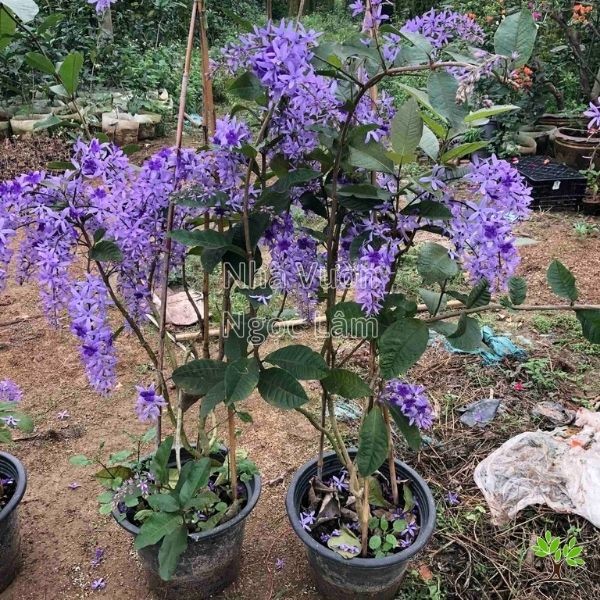
- Origin: Native to Mexico and Central America. Also sometimes referred to as Tropical Wisteria. Introduced to many tropical and subtropical regions long ago.
- Key Characteristics: A woody vine with abundant branching, known for its rapid growth and perennial nature. Stems are initially green and rounded, turning brown with age. Leaves are evergreen, glossy, dark green, oval or elongated with pointed ends. The striking feature is the inflorescence: long clusters of star-shaped, violet-blue flowers, typically 20-40cm long. Each flower has five petals with a darker blue or purple center. Blooms often appear continuously from spring to early autumn in warm climates.
- Care Tips: This is a robust vine that tolerates harsh conditions well, grows quickly, branches prolifically, and is relatively resistant to pests and diseases. Blue Trumpet Vine loves sun, tolerates drought and cold (to a degree), and is easy to grow and care for. It adapts to various soil types, including poor, slightly acidic, or calcareous soils. However, it prefers rich, well-draining soil with high organic content for optimal growth and flowering.
Climbing Rose
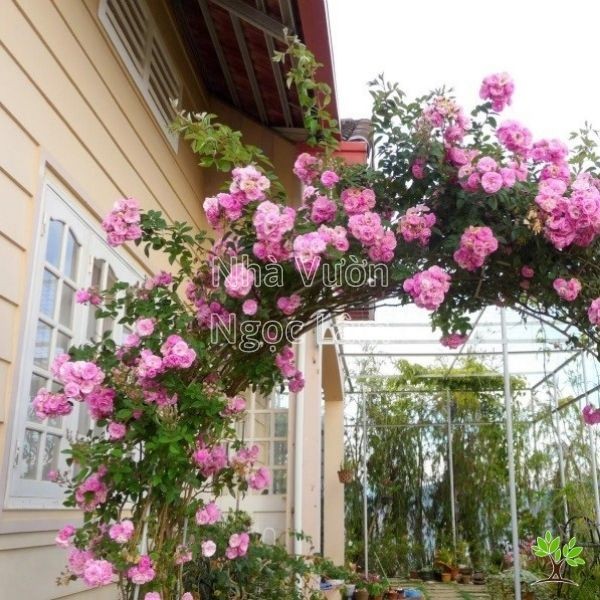 Pink Climbing Roses blooming on a trellis
Pink Climbing Roses blooming on a trellis
- Origin: Roses have a long history of cultivation worldwide, with many varieties originating from different regions. Climbing roses are cultivated forms or species adapted to grow vertically. They are highly popular for their diverse colors and fragrances.
- Key Characteristics: Climbing roses are woody perennials that need support to grow upwards. They are generally sun-loving plants. There are many varieties differing in size, color, flower form (single or double petals), and fragrance. They can bloom repeatedly throughout the year, but often show their most spectacular flush in late spring/early summer and sometimes again in autumn, especially when temperatures are cooler, leading to vigorous growth and larger, more vibrant blooms.
- Care Tips: Climbing roses can be challenging to care for. They require regular pruning to maintain shape, encourage flowering on new growth, and remove dead or diseased canes. Without consistent care, they can be susceptible to various fungal diseases (like black spot, powdery mildew) and pests (like aphids, spider mites). Proper watering, feeding, and air circulation are crucial for healthy growth and abundant blooms. Choosing a sunny location (at least 6-8 hours of direct sun) is vital for continuous flowering.
Rangoon Creeper (Combretum indicum)
- Origin: Native to tropical Asia and Africa. Known as “Dây giun” or “Sử quân tử” in Vietnamese, referring to its traditional use as an anthelmintic (dewormer).
- Key Characteristics: A vigorous, perennial, woody vine known for its rapid growth and ability to thrive in challenging conditions. It is evergreen in warm climates and deciduous in cooler ones. Leaves are opposite, ovate, and pointed. The flowers are fragrant and change color as they mature, starting white, turning pink, and finally becoming red or crimson. They appear in clusters and are particularly showy in summer. The plant is also known for its fruit, which is oblong and has medicinal properties. Its name “Sử quân tử” carries a meaning of enduring hardship while striving towards truth and light, reflecting the plant’s resilience.
- Care Tips: Rangoon Creeper is remarkably easy to care for, tolerating poor soil and drought once established. It requires watering, and occasional feeding will support better growth and flowering. While it can tolerate some shade, it blooms most prolifically in full sun. It is generally resistant to pests and diseases. Avoid waterlogged conditions as it is not tolerant of flooding. Pruning can help manage its vigorous growth.
Bougainvillea
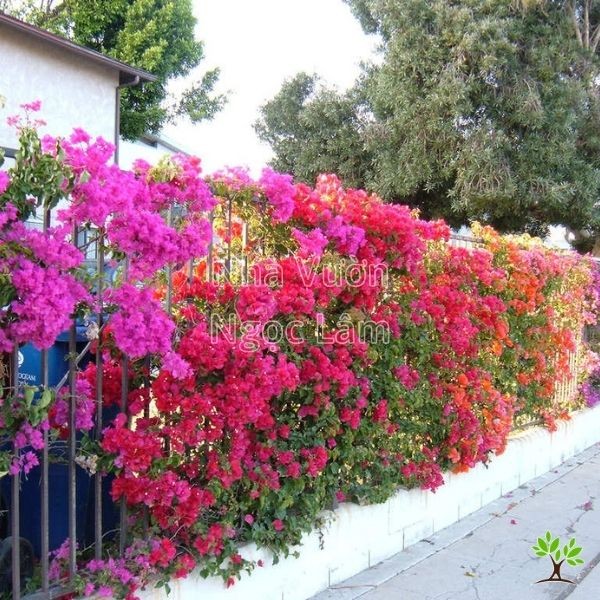 Vibrant pink Bougainvillea flowers covering a wall
Vibrant pink Bougainvillea flowers covering a wall
- Origin: Native to South America, specifically Brazil, Peru, and Argentina.
- Key Characteristics: Known for its incredibly vibrant, paper-like bracts (often mistaken for petals) that surround small white flowers. These bracts come in a wide range of colors including pink, red, purple, orange, yellow, and white. Bougainvillea is a woody, thorny vine that grows vigorously. Leaves are simple, alternate, ovate, and pointed. In cooler climates, leaves may drop in winter. There are single and double-bracted varieties; double varieties tend to hold their color longer (2-3 months) even after the actual flowers fade, while single varieties have a shorter peak bloom. Grafting techniques are often used to create plants with multiple colors on a single vine.
- Care Tips: Bougainvillea is a sun-worshipper and requires full sun (at least 6 hours daily) to flower abundantly. It is also remarkably drought-tolerant and prefers to be kept relatively dry between waterings. Overwatering encourages leafy growth at the expense of flowers. Strategic drying periods can actually stimulate blooming. Bougainvillea is well-suited to warm climates and can be sensitive to frost. Pruning is necessary to shape the plant and encourage more blooms, as flowers appear on new growth.
Golden Chain Vine (Petraeovitex bambusetorum)
 Cascading yellow Golden Chain Vine flowers
Cascading yellow Golden Chain Vine flowers
- Origin: Native to Southeast Asia, including regions of Vietnam. Sometimes called Yellow Chain Vine or Golden Orchid Vine.
- Key Characteristics: This is a cascading vine that typically reaches 0.5-2.5m in height but spreads horizontally. Leaves are ovate, slightly pointed at the tip, dark green, and glossy, resembling the leaves of some honeysuckle varieties. Its defining feature is the spectacular display of bright yellow, pendulous flower clusters that hang down like chains, often 50-100cm long. Flowers emerge from the leaf axils, resulting in a very floriferous display. The delicate stems, leaves, and long flower chains create a captivating, eye-catching effect. The flower chains are long-lasting, often blooming from autumn through spring in suitable climates.
- Care Tips: Originating from tropical regions, this vine grows strongly in warm climates. It is generally easy to grow and care for, being quite hardy and resistant to pests and diseases, tolerating some harsh weather conditions. Golden Chain Vine requires full sun to partial shade. More sun generally results in heavier flowering and brighter color. It prefers well-draining soil and regular watering, especially during dry periods.
Mandevilla (or Dipladenia)
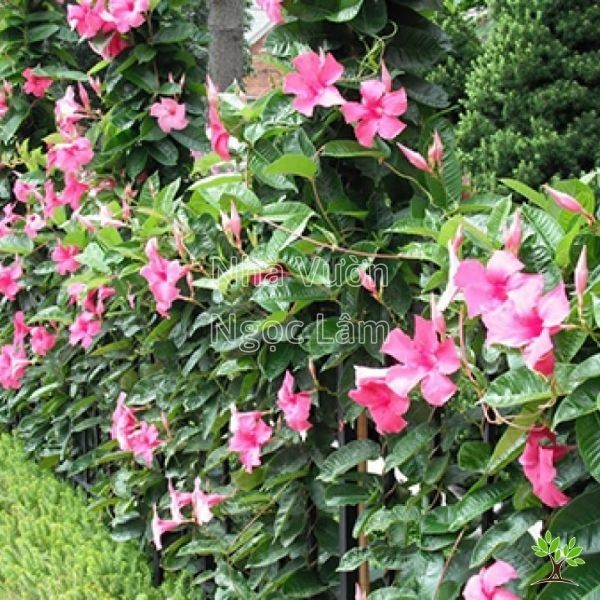 Pink Mandevilla flowers climbing a trellis
Pink Mandevilla flowers climbing a trellis
- Origin: Native to the tropical and subtropical regions of the Americas. The common names “Huỳnh anh” (often associated with yellow Allamanda) and “Hồng anh” (pink Mandevilla) can sometimes be confusingly applied. This description matches Mandevilla.
- Key Characteristics: These vines can climb or sprawl, reaching heights of up to 4.5m in favorable warm conditions. Mandevilla is typically an evergreen vine with herbaceous stems that are green or pinkish when young, becoming woody and grayish with age. Stems are pliable and easily trained. Leaves are simple, opposite, glossy green, ovate, and up to 6cm long and 3-5cm wide. The large, trumpet-shaped flowers are a major draw, commonly appearing in shades of pink (from pale to deep), but also available in red, white, or yellow varieties.
- Care Tips: Mandevilla prefers bright light but can tolerate partial shade. However, insufficient light will significantly reduce flowering. It thrives in warm, humid climates with temperatures ideally between 20-30°C. It needs well-draining soil rich in organic matter. Keep the soil consistently moist but avoid waterlogging. A common pest is the mealybug, which sucks sap and can cause leaf yellowing and stunted growth. Inspecting the plant for small white cottony clusters and treating with appropriate insecticidal soap or horticultural oil on a sunny day can control infestations. Regularly removing yellowing leaves and trimming leggy stems encourages bushier, healthier growth and more blooms. Applying ant killer around the base can help prevent ants from farming and protecting mealybugs.
Curtain Vine (Vernonia elliptica)
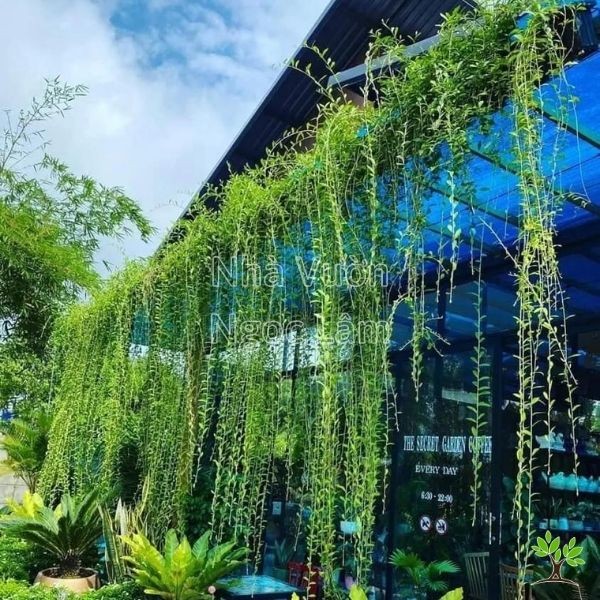 Dense green Curtain Vine foliage cascading downwards
Dense green Curtain Vine foliage cascading downwards
- Origin: Native to India. Also known as Parda Bel or Vernonia Creeper.
- Key Characteristics: This vine grows into long, dense curtains of foliage, giving rise to its common name. It’s ideal for planting on balconies or elevated positions where it can hang down, creating a thick green wall that blocks sun and adds a cool, refreshing feel. Stems are green and covered with fine gray hairs when young, turning brown with age. The pliable stems are easy to train or allow to trail. Unlike some vines, it doesn’t produce aerial roots that cling to walls, making it a cleaner option for vertical coverage. Leaves are dark green, thick, sturdy, rarely shedding, and remain green year-round. They are ovate with pointed tips, growing densely along short leaf stalks. Flowers are small, typically pale pink, appearing in clusters, each with five tiny petals.
- Care Tips: Curtain Vine is remarkably easy to care for and adaptable. It can tolerate full sun to partial shade and even thrives in very low light conditions. It withstands both heat and cold well and remains green in winter, not shedding leaves. It has moderate watering needs; water regularly when young to encourage fast growth (at least once daily), but reduce frequency once established, watering based on weather and soil dryness. It is generally pest and disease resistant.
Coral Vine (Antigonon leptopus)
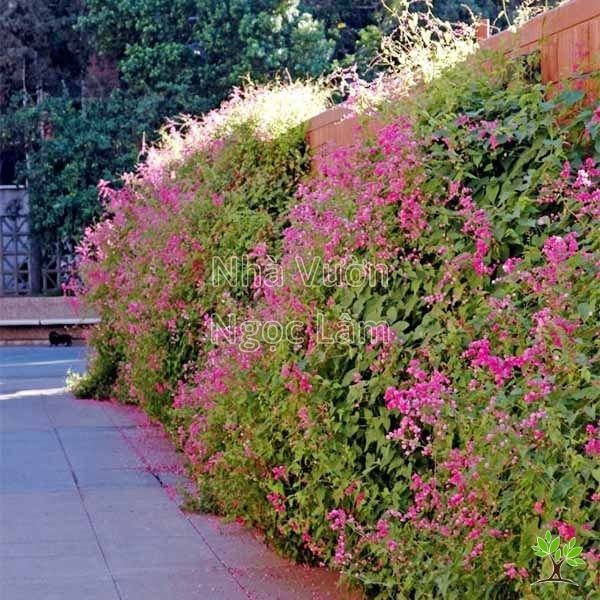 Pink Coral Vine flowers in heart shapes
Pink Coral Vine flowers in heart shapes
- Origin: Native to Mexico. Also known as Queen’s Wreath, Chain of Love, or Heart Vine (due to the leaf shape). Despite its delicate appearance, it is a vigorous grower.
- Key Characteristics: This vine climbs easily using tendrils and can reach heights of 10-12m or more. It is a perennial vine with striking heart-shaped leaves that may have hairs on the underside. The flowers are its main attraction, forming dense clusters of pink or reddish-pink blooms. Each flower has five petals and is distinctively shaped, sometimes referred to as “broken heart” flowers (hence the Vietnamese name “hoa tim vỡ” or “hiếu nữ”). In suitable climates, it can bloom year-round. The flowers produce brown, three-angled fruits containing seeds.
- Care Tips: Coral Vine is a sun-loving plant and requires plenty of sunlight for best growth and flowering. Place pots or plant in areas with ample light. The ideal temperature range for growth is 18-30°C. It is quite drought-tolerant once established but prefers consistent moisture, so water daily, especially during hot summer days (perhaps twice a day in extreme heat) to prevent the soil from drying out and maintain humidity. It is generally easy to grow and can tolerate a variety of well-draining soils.
Morning Glory (Ipomoea)
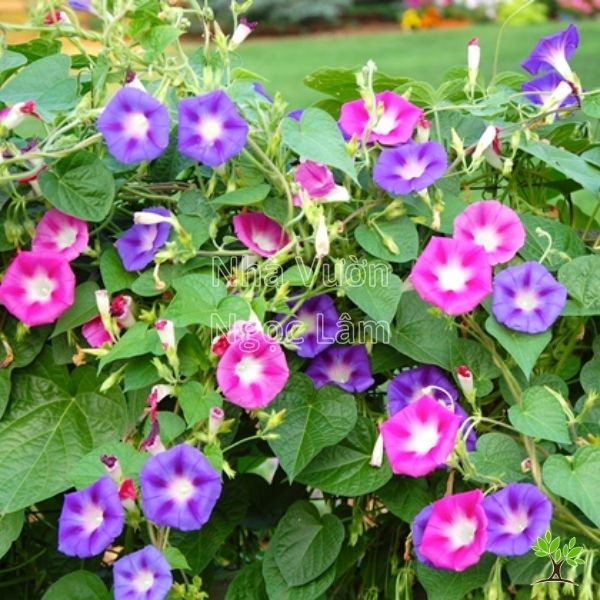 Purple Morning Glory flowers blooming in the morning sun
Purple Morning Glory flowers blooming in the morning sun
- Origin: Various species are native to tropical and subtropical regions worldwide. Known as “Triều nhan” or “Asagao” (Japanese) in some areas. Popular for its ease of cultivation.
- Key Characteristics: Morning glories are typically fast-growing annual or perennial vines that twine around supports. Flowers are trumpet or funnel-shaped, often 5cm wide, and come in vibrant colors including purple, blue, red, pink, and white, sometimes with a white throat. Flowers emerge from the leaf axils on short stalks. A unique characteristic is their blooming habit – flowers typically open in the morning and close by afternoon, especially on sunny days, appearing brighter and more radiant in the early light. Leaves are generally heart-shaped or lobed.
- Care Tips: Morning glories are sun-loving plants that can tolerate partial shade, but they need significant sunlight throughout their growing period to flower profusely. Plant them along fences, arbors, or on patios and balconies where they receive plenty of light. They adapt to average soil but perform best in well-draining soil. They are relatively drought-tolerant but benefit from regular watering, especially during dry spells.
Trumpet Vine (Campsis radicans)
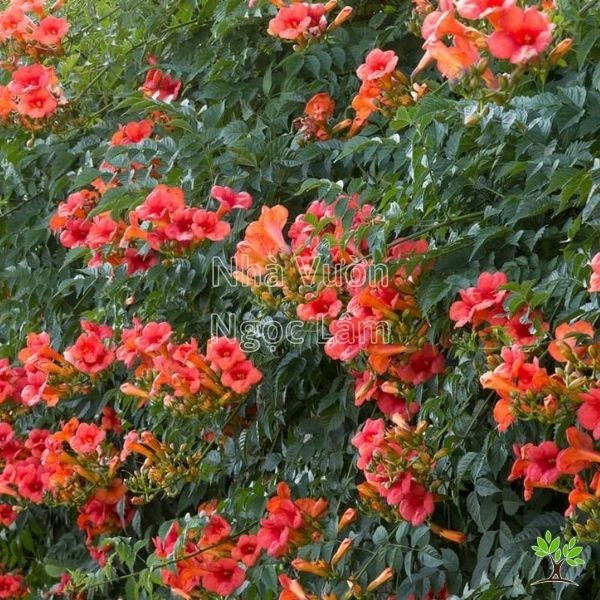 Orange Trumpet Vine flowers hanging in clusters
Orange Trumpet Vine flowers hanging in clusters
- Origin: Native to the southeastern United States. Known for its aggressive growth and vibrant flowers.
- Key Characteristics: A fast-growing, woody vine that clings to surfaces using aerial roots and twining stems. Leaves are dark green, compound, with serrated edges that are not sharp to touch. Leaves turn yellow and drop in winter, regrowing vigorously in spring. The striking trumpet-shaped flowers are typically orange or reddish-orange, resembling small bells. They bloom in clusters of 5-8 flowers, usually from summer (around May) to early autumn (October). Each cluster lasts about 5-7 days before fading.
- Care Tips: Trumpet vine is very vigorous and hardy, tolerating drought and harsh conditions well, making it easy to grow and care for. It is relatively pest and disease resistant. Like many climbing plants, it is a full-sun lover; the more sun it receives, the more flowers it will produce with deeper colors. It thrives in well-ventilated areas like balconies and gets enough water, even if planted facing east. In insufficient light, it tends to produce abundant foliage with few or no flowers. Due to its aggressive nature, it may require regular pruning to keep it under control.
Hanging Root Vine (Based on description from original article)
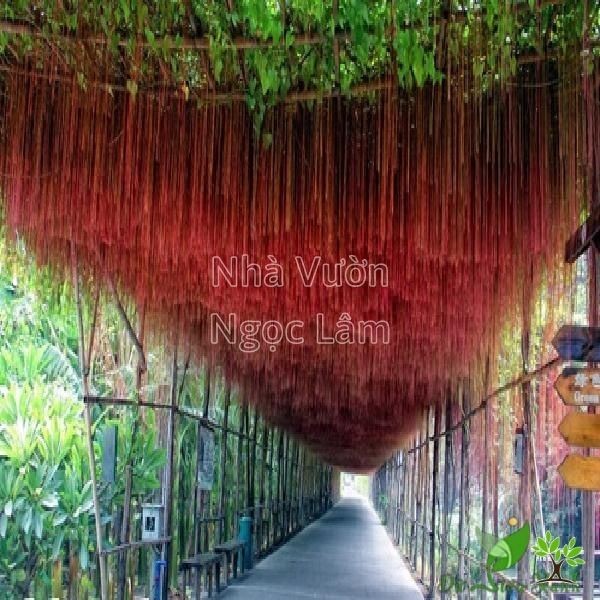 Dense green foliage of a Hanging Root Vine with long aerial roots
Dense green foliage of a Hanging Root Vine with long aerial roots
- Origin: Described as originating from natural regions in the Americas, from North to Central and South America. Known as “Dây liêm hồ đằng”.
- Key Characteristics: This vine is described as a fast-growing climber capable of attaching firmly to supports like trellises or tall branches. Its most unique feature is the aerial roots that grow from the stem and hang downwards, sometimes reaching 3-5 meters long, brown-gray or pinkish, resembling long threads. These hanging roots are often utilized decoratively by growing the vine on an arbor and allowing the roots to drape down like a natural curtain. Leaves are large, heart-shaped, pointed at the tip, smooth, and serrated along the edges. Flowers are described as appearing in clusters of creamy yellow or white-green with a wavy surface texture. The fruit is described as round and spherical, green when unripe, turning red when ripe, with a smooth, glossy exterior and small seeds inside. This vine is described as shedding few leaves and having long branches.
- Care Tips: This vine can be planted year-round and does not adhere to a specific season for planting. Before planting, prepare a trellis or support structure for the vines to twine and climb. It is sun-loving and prefers areas with plenty of light, not suitable for deep shade. It requires daily watering, especially during its initial growth phase, mainly to keep the soil moist but not waterlogged, as it does not tolerate standing water.
Golden Dewdrop (Duranta erecta) or Golden Showers (Galphimia glauca)
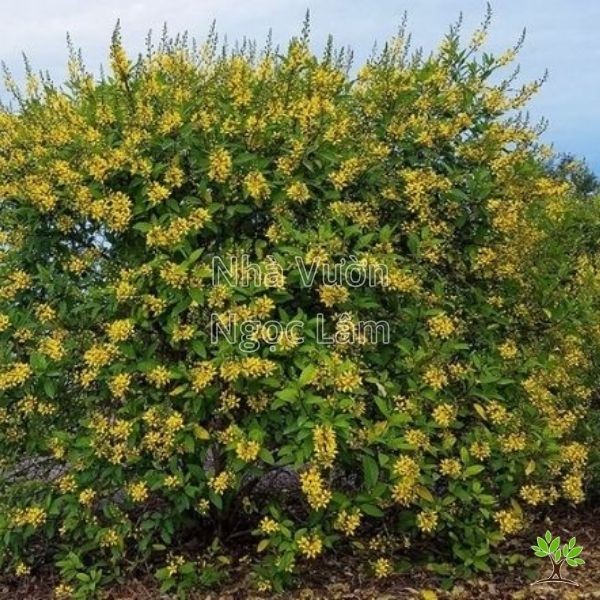 Yellow flowers of Golden Dewdrop or Golden Showers
Yellow flowers of Golden Dewdrop or Golden Showers
- Origin: Golden Dewdrop is native to the Americas (Florida to Argentina), while Golden Showers is native to Mexico and Central America. Both are known as “Cây kim đồng”, “Mai hoàng yến”, or “Mai nhật” in Vietnamese, referring to their yellow flowers and sometimes sprawling or climbing habit. The description suggests characteristics of both or a similar yellow-flowered plant. Let’s assume it refers to the general group.
- Key Characteristics: These plants can grow as sprawling shrubs or be trained as vines, reaching heights of 0.5-3m. Stems may contain milky sap, young branches are soft and pale green with fine hairs, and older stems have bumpy nodes. Leaves are oval or pointed at both ends, shiny light green, with smooth edges. Flowers are typically bright yellow, often resembling small plum blossoms with five spreading petals and prominent yellow or red stamens. They often appear in clusters (3-9 flower spikes per cluster) and are long-lasting.
- Care Tips: These plants are easy to grow and care for, requiring only a small space with enough sun and wind to thrive. They are very sun-loving, and more sun leads to more abundant and vibrant flowers. In shaded areas, growth is poor and flowering is reduced or absent. The ideal temperature range is 18-35°C; growth stops below 10°C. They can tolerate heat but are less cold-tolerant, often dying back in winter and regrowing when temperatures warm up. Provide regular watering and well-draining soil.
Shower of Gold Vine (Tristellateia australasiae)
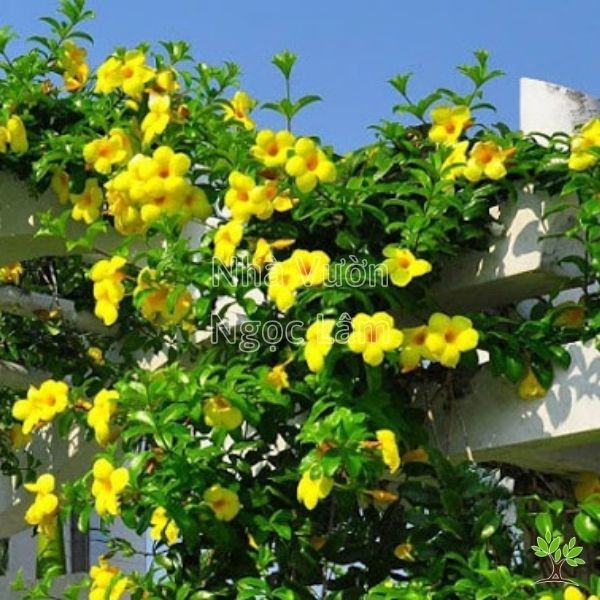 Bright yellow flowers of Shower of Gold Vine
Bright yellow flowers of Shower of Gold Vine
- Origin: Native to Southeast Asia, Northern Australia, and the Pacific Islands. Known as “Hoàng thảo” or “Huynh đệ” in Vietnamese, signifying brotherly bond or solidarity, and its vibrant yellow color is associated with luck and prosperity.
- Key Characteristics: A woody climbing vine with abundant branching, twining stems, and a long lifespan. Young stems are green and pliable, turning brown with age. Leaves are soft, thin, ovate or rounded with pointed tips, glossy green, and grow oppositely on the stem. Flowers are bell-shaped, bright yellow, with five delicate petals, appearing at the ends of branches. The name “Shower of Gold” perfectly describes the visual effect when in full bloom.
- Care Tips: This vine is generally easy to grow and care for, and rarely suffers from pests or diseases. It is a sun-loving plant that tolerates drought well. However, it cannot withstand waterlogging or cold temperatures. If planted in a shady area, it will produce very few flowers. The ideal temperature range for optimal growth and abundant flowering is 22-30°C. Provide adequate water, especially during dry periods, but ensure good drainage.
Butterfly Pea (Clitoria ternatea)
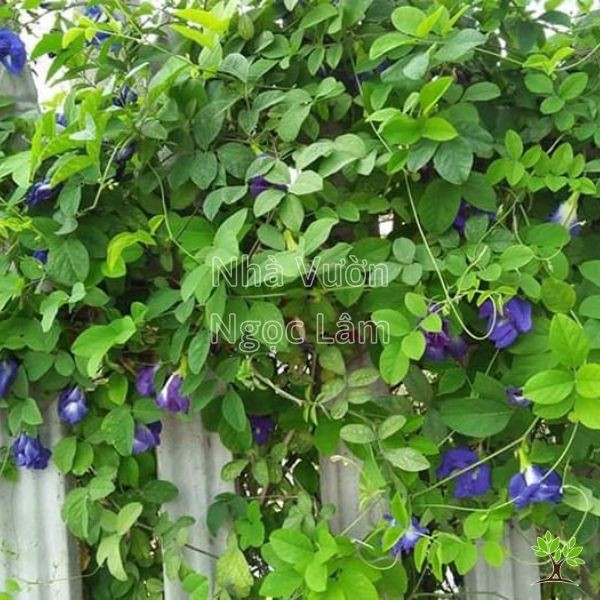 Blue Butterfly Pea flowers
Blue Butterfly Pea flowers
- Origin: Native to Southeast Asia. Also known as Bluebellvine, Blue Pea, or Darwin Pea.
- Key Characteristics: This vine is a vigorous climber with abundant branching, providing good coverage. It climbs using tendrils on its stems. Stems are green and herbaceous when young, becoming woody and brownish with age; they can trail up to 10m long. Stems and branches may have fine hairs. It has dense foliage of dark green, compound leaves (resembling peanut leaves) that remain green year-round. The flowers are the highlight – typically vibrant blue or deep blue-violet, but also available in white or light blue varieties. They are uniquely shaped, resembling a clam shell or female anatomy (hence the scientific name), and appear singly or in clusters from the leaf axils, leading to prolific flowering.
- Care Tips: Butterfly Pea is an easy-to-grow, low-maintenance vine. It tolerates heat and drought well and is relatively resistant to pests and diseases, though it is sensitive to cold. The ideal temperature range for growth is 20-32°C. It prefers sunny locations but can tolerate partial shade. Full sun and good ventilation will result in more flowers. It adapts to various soil types but prefers well-draining soil. Provide regular watering, especially during dry spells. The plant is also known for its nitrogen-fixing properties, improving soil quality.
Choosing the Right Climbing Plant for Your Space
Selecting the perfect vine requires considering a few key factors:
- Climate and Hardiness Zone: Ensure the plant is suited to your region’s temperatures and growing season. Some prefer tropical heat, others tolerate frost.
- Light Conditions: Match the plant’s light needs (full sun, partial shade, full shade) to the intended planting location.
- Support Structure: Consider the vine’s growth habit and weight. Some twine gently, others cling with roots or tendrils, and vigorous woody vines need very sturdy support like a pergola or strong arbor.
- Maintenance: Some vines are low-maintenance, while others require regular pruning, feeding, or pest control.
- Desired Effect: Are you looking for dense foliage for shade/privacy, abundant colorful flowers, fragrance, or attracting wildlife?
Where to Find Your Perfect Vine
Finding healthy, high-quality climbing plants is the first step to a beautiful vertical garden. Biogarden.Asia is a trusted source for a wide variety of climbing plants and other horticultural products. We offer expert advice to help you choose the right plants for your specific needs and provide guidance on how to care for them to ensure they thrive. Whether you’re looking for a fast-growing privacy screen or a fragrant floral display, explore the selections available at Biogarden.Asia.
In summary, climbing plants offer a fantastic way to add beauty, shade, and life to your home and garden space. By understanding their benefits and characteristics, and choosing the right variety for your conditions, you can create stunning vertical displays. We hope this guide from the experts at Biogarden.Asia has been helpful in introducing you to some popular climbing plant options and providing essential care tips. Don’t forget to visit Biogarden.Asia often to explore more plant varieties and gardening resources!



